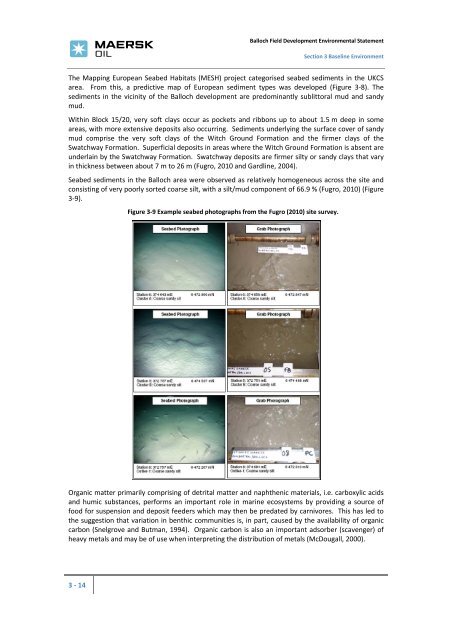Environmental Statement - Maersk Oil
Environmental Statement - Maersk Oil
Environmental Statement - Maersk Oil
Create successful ePaper yourself
Turn your PDF publications into a flip-book with our unique Google optimized e-Paper software.
3 ‐ 14<br />
Balloch Field Development <strong>Environmental</strong> <strong>Statement</strong><br />
Section 3 Baseline Environment<br />
The Mapping European Seabed Habitats (MESH) project categorised seabed sediments in the UKCS<br />
area. From this, a predictive map of European sediment types was developed (Figure 3‐8). The<br />
sediments in the vicinity of the Balloch development are predominantly sublittoral mud and sandy<br />
mud.<br />
Within Block 15/20, very soft clays occur as pockets and ribbons up to about 1.5 m deep in some<br />
areas, with more extensive deposits also occurring. Sediments underlying the surface cover of sandy<br />
mud comprise the very soft clays of the Witch Ground Formation and the firmer clays of the<br />
Swatchway Formation. Superficial deposits in areas where the Witch Ground Formation is absent are<br />
underlain by the Swatchway Formation. Swatchway deposits are firmer silty or sandy clays that vary<br />
in thickness between about 7 m to 26 m (Fugro, 2010 and Gardline, 2004).<br />
Seabed sediments in the Balloch area were observed as relatively homogeneous across the site and<br />
consisting of very poorly sorted coarse silt, with a silt/mud component of 66.9 % (Fugro, 2010) (Figure<br />
3‐9).<br />
Figure 3‐9 Example seabed photographs from the Fugro (2010) site survey.<br />
Organic matter primarily comprising of detrital matter and naphthenic materials, i.e. carboxylic acids<br />
and humic substances, performs an important role in marine ecosystems by providing a source of<br />
food for suspension and deposit feeders which may then be predated by carnivores. This has led to<br />
the suggestion that variation in benthic communities is, in part, caused by the availability of organic<br />
carbon (Snelgrove and Butman, 1994). Organic carbon is also an important adsorber (scavenger) of<br />
heavy metals and may be of use when interpreting the distribution of metals (McDougall, 2000).








